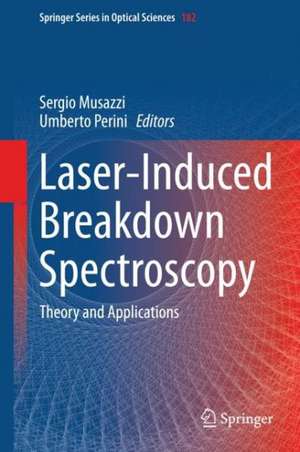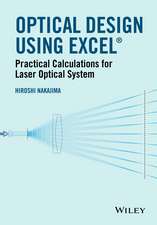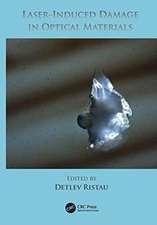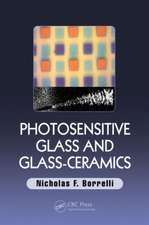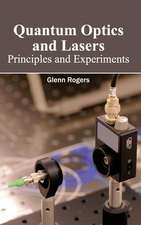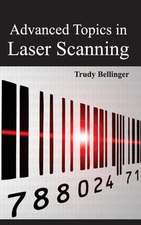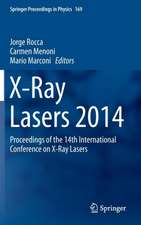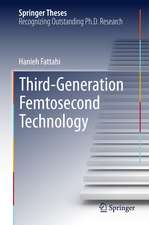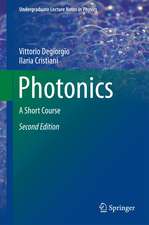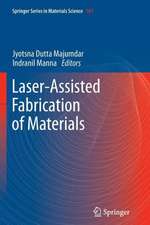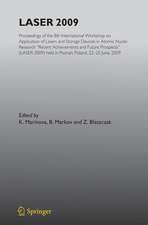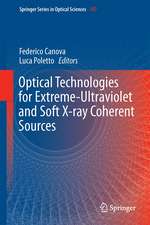Laser-Induced Breakdown Spectroscopy: Theory and Applications: Springer Series in Optical Sciences, cartea 182
Editat de Sergio Musazzi, Umberto Perinien Limba Engleză Hardback – 12 mar 2014
| Toate formatele și edițiile | Preț | Express |
|---|---|---|
| Paperback (1) | 1394.03 lei 6-8 săpt. | |
| Springer Berlin, Heidelberg – 3 sep 2016 | 1394.03 lei 6-8 săpt. | |
| Hardback (1) | 1398.80 lei 6-8 săpt. | |
| Springer Berlin, Heidelberg – 12 mar 2014 | 1398.80 lei 6-8 săpt. |
Din seria Springer Series in Optical Sciences
- 24%
 Preț: 945.47 lei
Preț: 945.47 lei - 18%
 Preț: 1850.21 lei
Preț: 1850.21 lei - 18%
 Preț: 2124.06 lei
Preț: 2124.06 lei - 20%
 Preț: 568.47 lei
Preț: 568.47 lei - 18%
 Preț: 1118.93 lei
Preț: 1118.93 lei - 18%
 Preț: 999.76 lei
Preț: 999.76 lei - 18%
 Preț: 957.62 lei
Preț: 957.62 lei - 18%
 Preț: 892.11 lei
Preț: 892.11 lei - 15%
 Preț: 648.56 lei
Preț: 648.56 lei - 18%
 Preț: 1838.07 lei
Preț: 1838.07 lei -
 Preț: 379.86 lei
Preț: 379.86 lei - 18%
 Preț: 1392.95 lei
Preț: 1392.95 lei - 18%
 Preț: 1232.89 lei
Preț: 1232.89 lei - 18%
 Preț: 1568.95 lei
Preț: 1568.95 lei - 18%
 Preț: 2095.49 lei
Preț: 2095.49 lei - 18%
 Preț: 1227.84 lei
Preț: 1227.84 lei - 15%
 Preț: 643.65 lei
Preț: 643.65 lei - 18%
 Preț: 954.45 lei
Preț: 954.45 lei - 18%
 Preț: 947.35 lei
Preț: 947.35 lei - 18%
 Preț: 1241.55 lei
Preț: 1241.55 lei - 18%
 Preț: 947.04 lei
Preț: 947.04 lei -
 Preț: 392.21 lei
Preț: 392.21 lei - 18%
 Preț: 997.53 lei
Preț: 997.53 lei - 18%
 Preț: 1562.31 lei
Preț: 1562.31 lei - 18%
 Preț: 1110.24 lei
Preț: 1110.24 lei - 15%
 Preț: 651.19 lei
Preț: 651.19 lei -
 Preț: 414.69 lei
Preț: 414.69 lei - 18%
 Preț: 952.57 lei
Preț: 952.57 lei - 15%
 Preț: 641.03 lei
Preț: 641.03 lei - 15%
 Preț: 635.80 lei
Preț: 635.80 lei
Preț: 1398.80 lei
Preț vechi: 1705.85 lei
-18% Nou
Puncte Express: 2098
Preț estimativ în valută:
267.74€ • 290.93$ • 225.05£
267.74€ • 290.93$ • 225.05£
Carte tipărită la comandă
Livrare economică 21 aprilie-05 mai
Preluare comenzi: 021 569.72.76
Specificații
ISBN-13: 9783642450846
ISBN-10: 3642450849
Pagini: 565
Ilustrații: XXII, 565 p. 244 illus., 34 illus. in color.
Dimensiuni: 155 x 235 x 38 mm
Greutate: 0.95 kg
Ediția:2014
Editura: Springer Berlin, Heidelberg
Colecția Springer
Seria Springer Series in Optical Sciences
Locul publicării:Berlin, Heidelberg, Germany
ISBN-10: 3642450849
Pagini: 565
Ilustrații: XXII, 565 p. 244 illus., 34 illus. in color.
Dimensiuni: 155 x 235 x 38 mm
Greutate: 0.95 kg
Ediția:2014
Editura: Springer Berlin, Heidelberg
Colecția Springer
Seria Springer Series in Optical Sciences
Locul publicării:Berlin, Heidelberg, Germany
Public țintă
ResearchCuprins
Part I Fundamentals of LIBS.- Physical processes in optical emission spectroscopy.- A review of LIBS instrumental techniques.- Effect of atmospheric conditions on LIBS spectra.- Temporal evolution of the LIBS signals.- The LIBS double pulse technique.- Part II Applications of LIBS.- Analysis of solid materials by means of LIBS.- Analysis of liquids/aerosol by means of LIBS.- Detection of contaminants in soil by means of LIBS.- Forensic applications by means of LIBS.- Biological applications of LIBS.- LIBS analysis of coal.- Detection of explosives in traces.- Cultural heritage applications of LIBS.- Space applications of LIBS.- Identification of polymers by means of LIBS.
Recenzii
“The subject of this book concerns a theoretical description of the laser-induced breakdown spectroscopy (LIBS) technique … . this book of large interest to the large community of consumers, researchers and developers of the LIBS techniques.” (Francesco Caridi, Contemporary Physics, Vol. 58 (3), June, 2017)
Textul de pe ultima copertă
This book deals with the Laser-Induced Breakdown Spectroscopy (LIBS), a widely used atomic emission spectroscopy technique for elemental analysis of materials. It is based on the use of a high-power, short pulse laser excitation. The book is divided into two main sections: the first one concerning theoretical aspects of the technique, the second one describing the state of the art in applications of the technique in different scientific/technological areas. Numerous examples of state of the art applications provide the readers an almost complete scenario of the LIBS technique. The LIBS theoretical aspects are reviewed. The book helps the readers who are less familiar with the technique to understand the basic principles. Numerous examples of state of the art applications give an almost complete scenario of the LIBS technique potentiality. These examples of applications may have a strong impact on future industrial utilization. The authors made important contributions to the developmentof this field.
Caracteristici
Provides readers with numerous examples of state-of-the-art applications with an almost complete scenario of the LIBS technique potentiality Reviews the LIBS theoretical aspects Helps readers who are less familiar with the technique to understand basic principles Includes examples of applications that may have strong impact on future industrial utilization (e.g. on line analysis of coal elemental composition) Includes supplementary material: sn.pub/extras
